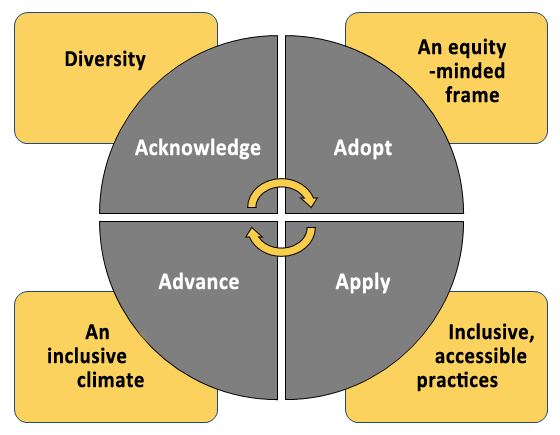| |
CETL | Canvas | AI Guide | Course Design | Online | Software | Workshops
Advancing Diversity, Equity, Inclusion, and Accessibility
in Courses and the Curriculum (DEIA)
Foundation
Acknowledge…
…the diversity of our students and diverse ways of engaging, representing, and expressing knowledge, skills, and learning
Adopt…
…an equity-minded framework for assessing our own practices and removing barriers to student learning and engagement
Apply…
…pedagogical principles and practices that advance academic success for ALL students
Advance…
…a climate of mutual respect, civility, accessibility, and inclusivity.

Process
Inclusion by Design provides an easy way to imagine, look for, and apply inclusive practices in our courses and curricula. It also reminds us that inclusive and accessible learning experiences don’t just happen; they have to be created and fostered with intentionality. The good news is, there are a few simple steps we can take to make a big difference. Here’s how:
- Course syllabi - this is our students’ first and potentially most enduring encounter with a class and its expectations, and an excellent place to introduce a respect for diversity and a commitment to accessibility and inclusivity.
- The first day of class – first impressions matter and discussing how we will make an effort to foster inclusive and accessible learning --and to articulate the value of it-- sets expectations in a conversational and welcoming manner.
- Every day of class – words matter, and the words we use in our classes, our communications, and our encounters don’t simply set but sustain the tone of commitment to diversity, equity, inclusion, and accessibility.
- Assignments and activities – this is where many students will see –or not see—the evidence of our efforts. Are assignments and learning activities universally designed? Are they transparent? Are they accessible and inclusive?
- Student- and program learning outcomes – are any of the principles of DEIA embedded in course SLOs and program PLOs?
- Instructional methods – are they inclusive or are they “one size fits all” (which never fit)? The key thing is for our actions to match our rhetoric.
Want to learn more?
CETL has an abundance of resources, guides, and materials to help you develop, adopt, or adapt syllabi statements, teaching practices, and communication strategies that can make a big difference in the learning and lives of our students.
RESOURCE MATERIALS
|